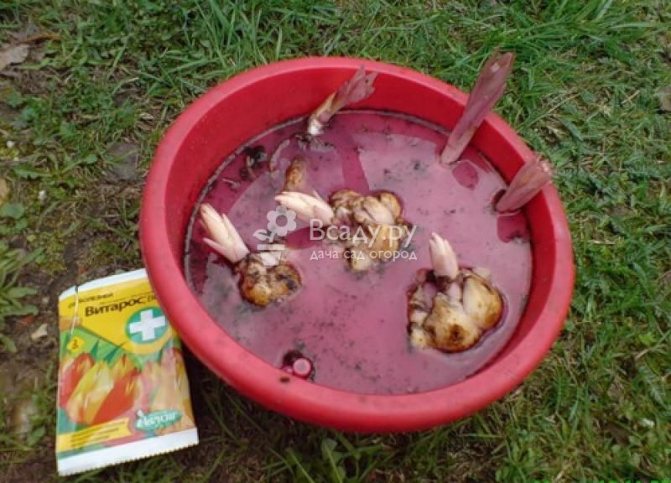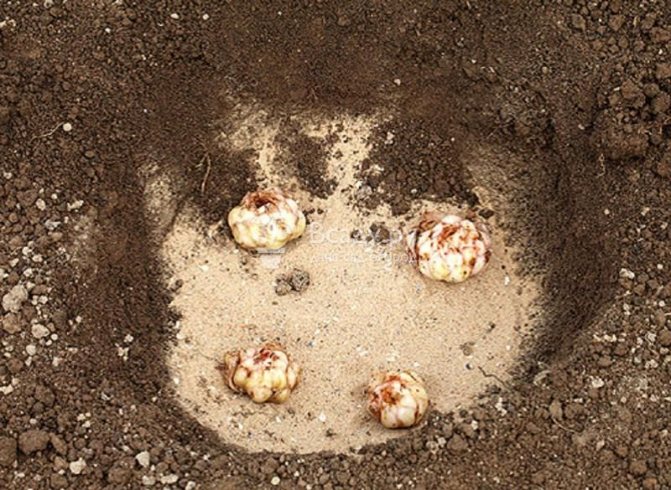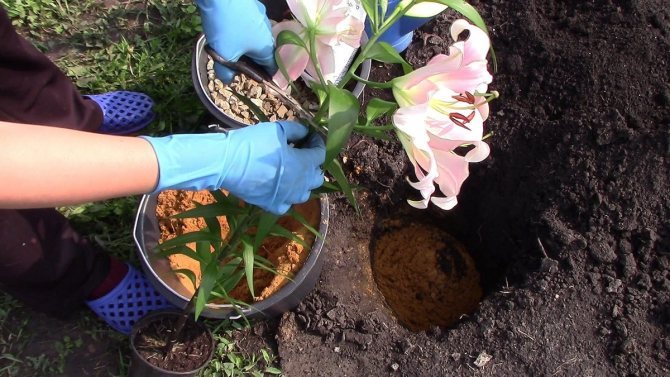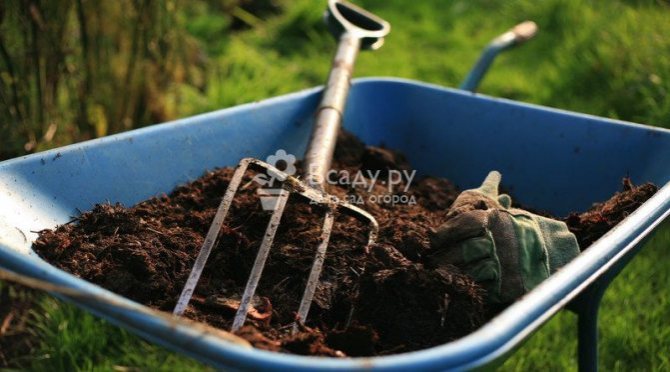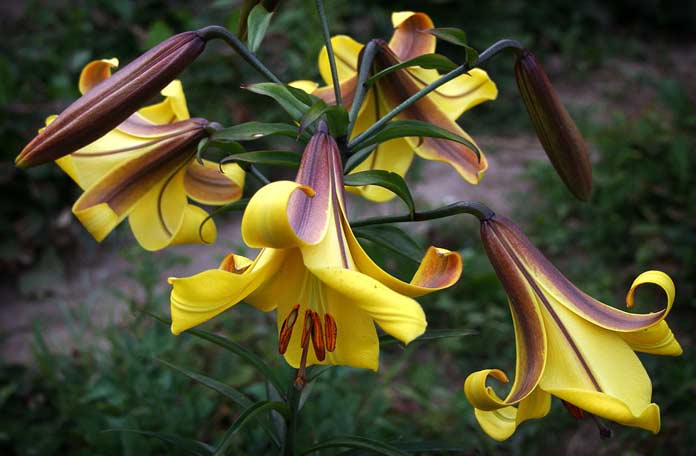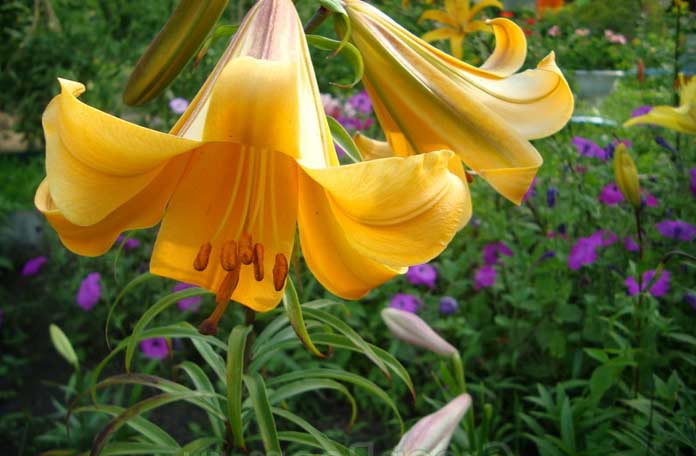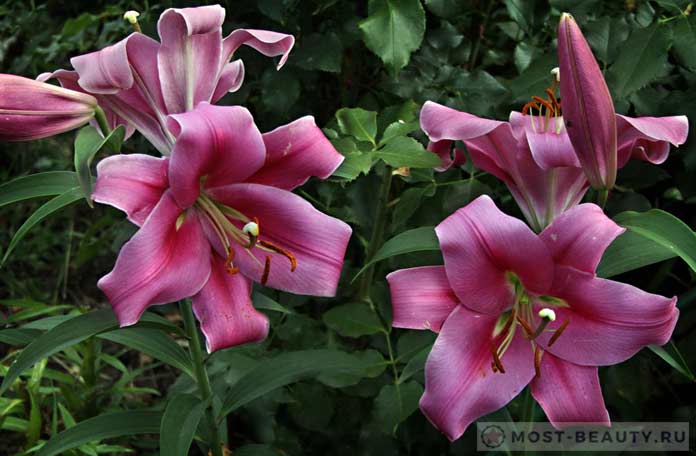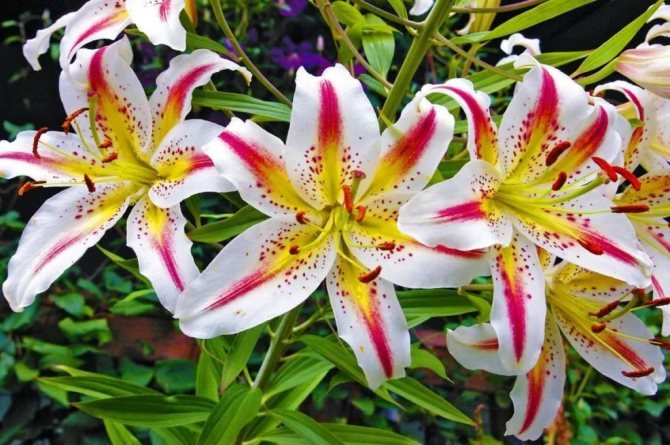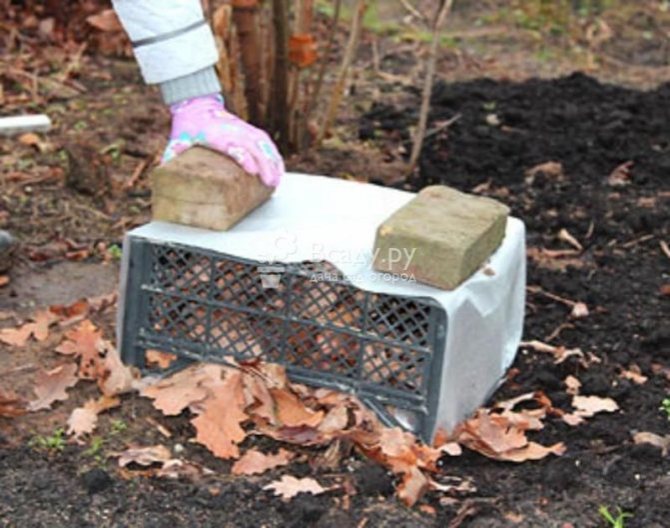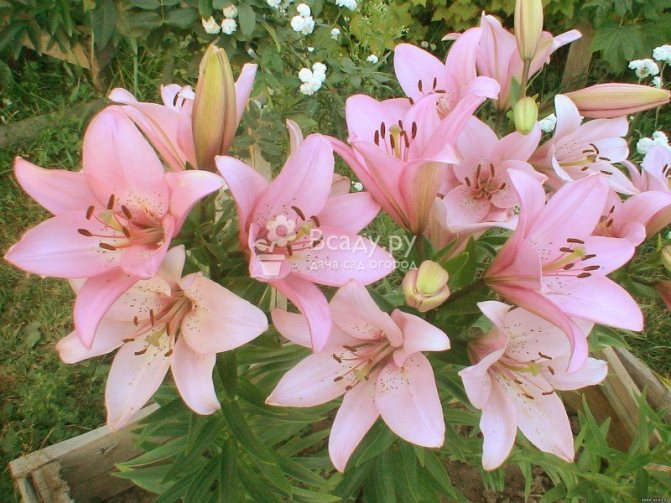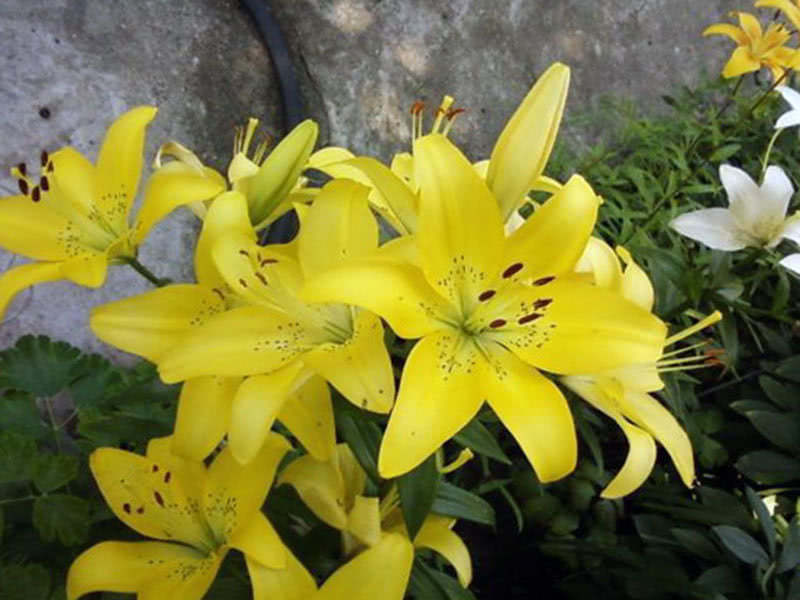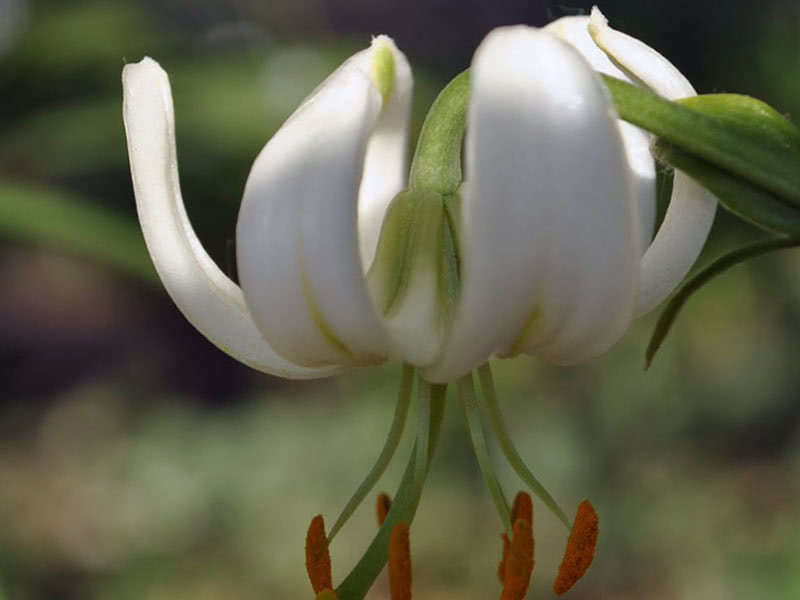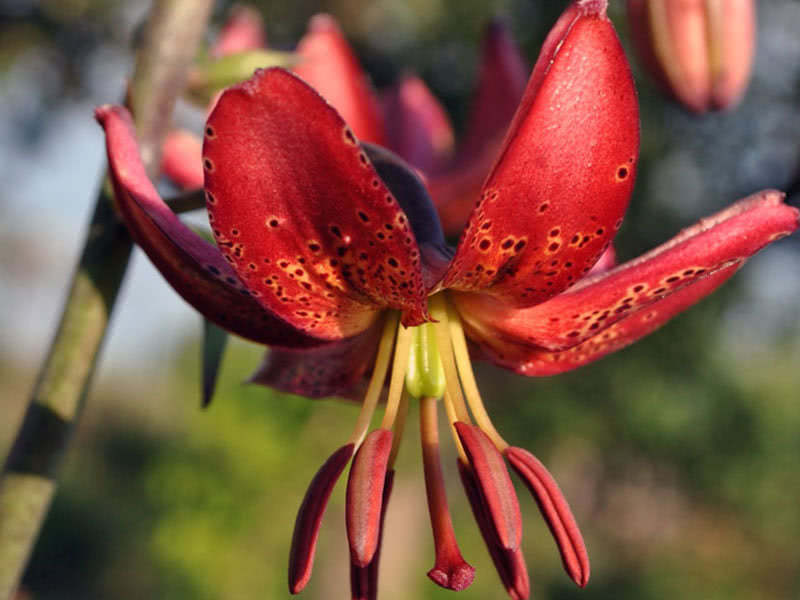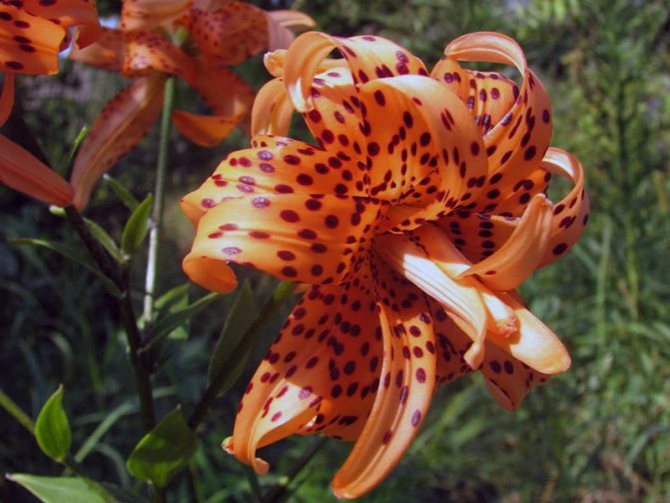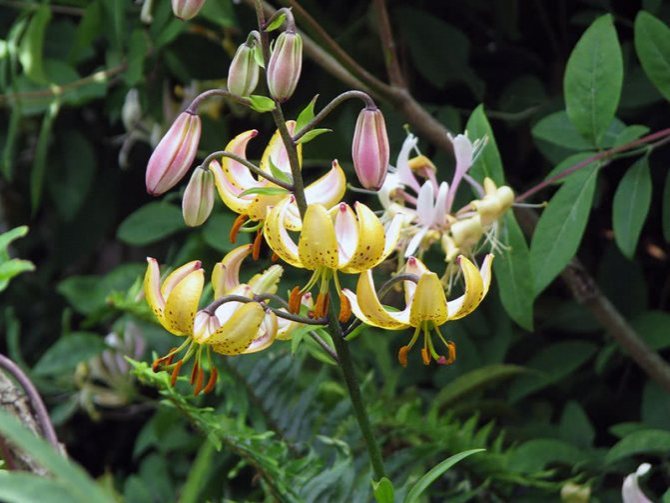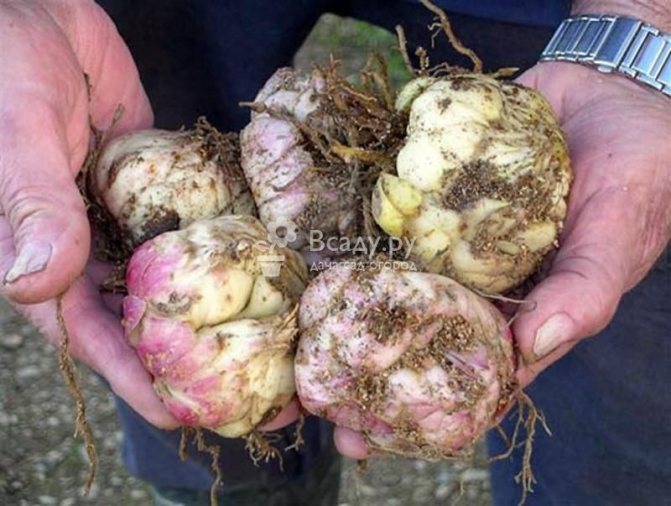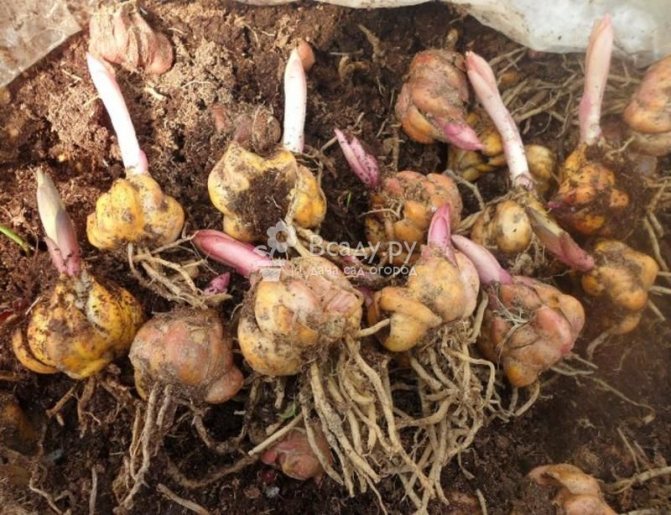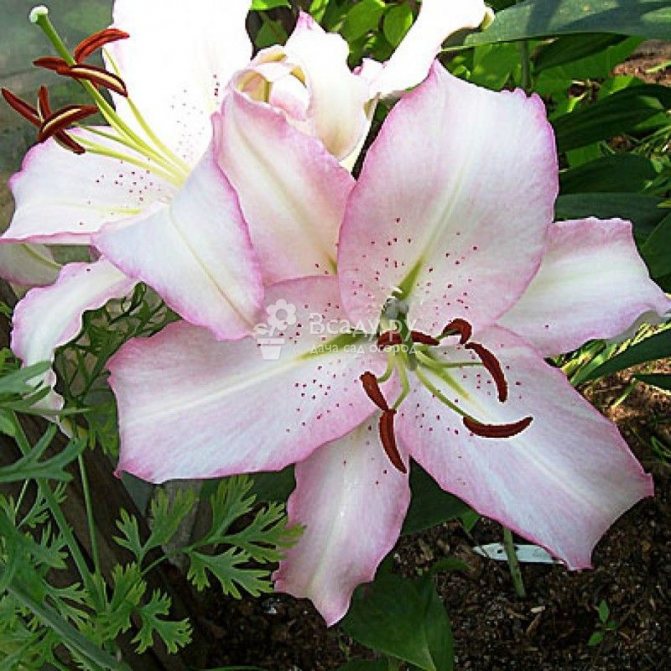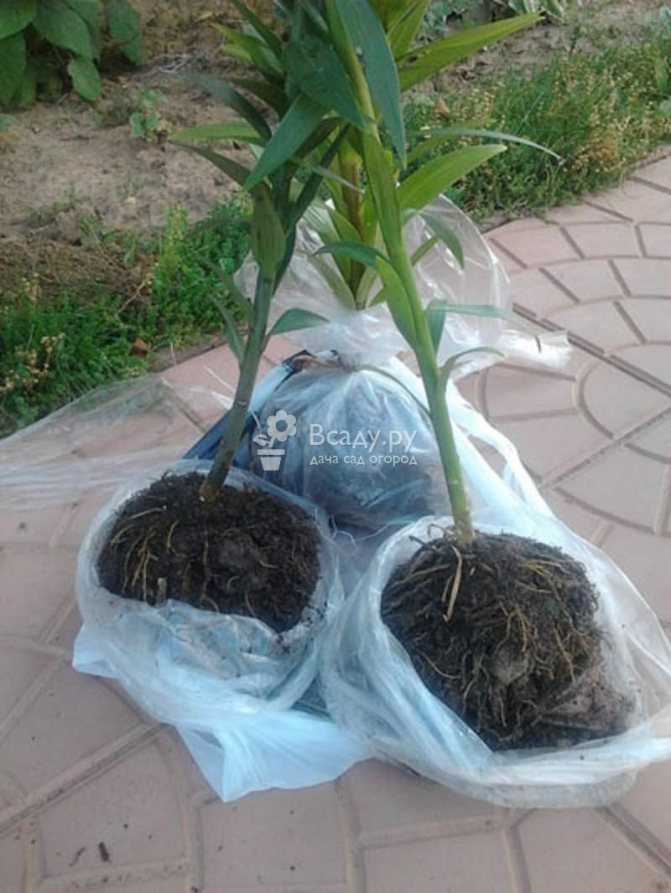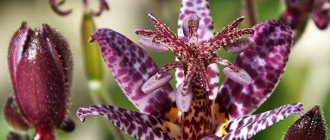Many centuries ago, the ancient Greeks believed that the white lily was a symbol of purity, innocence and refined beauty. Legend has it: the mother of the gods Hera found, hidden from her, the baby Hercules, the son of Zeus and a mortal woman. Taking pity on the baby, she wanted to give him milk, but the boy bit her on the breast. Milk spilled over the sky and flowed through the Milky Way. A few drops of divine milk fell to the ground and sprouted into beautiful white lilies.
How can a simple gardener grow this divine flower?
Planting lilies in the spring in the ground
Both autumn and spring planting of bulbs is practiced. Experienced gardeners prefer to plant them in the fall. The reason is that the bulbs planted in spring do not have time to get strong enough by the arrival of autumn, their roots do not fulfill their function sufficiently, therefore, the plant is nourished only at the expense of the bulb itself, as a result of which its scales become thin, and the roots darken and begin to die off ... The second disadvantage of spring planting is the lack of babies on the bulbs, which is important for breeding.
In addition, some bulbs may die during the winter, so some gardeners still prefer spring planting, citing a number of reasons:
- The desired variety can be freely purchased at any time of the year, so there is no need to breed them by children.
- Bulbs dug up in the fall are kept fairly well in the refrigerator, which means they will not die in winter as a result of soaking or freezing.
- There is always an opportunity to provide the right conditions for the successful growth and flowering of a crop in a new place.
Considering all the advantages and disadvantages of planting lilies in the spring in the ground, we can conclude that the choice of the season for planting should be based on varieties and types of flowers.
Note: For example, lilies with a late flowering period will bloom much better when planted in spring, but there is no point in planting North American varieties in spring. In addition, the climatic conditions in your area can also affect the timing of planting. So, if the summer is short and cold in the area where you live, then it is not recommended to carry out spring planting, since the crops will bloom only next year. It would be much more rational to plant them in the middle of autumn.
It is also not recommended to plant lilies in late spring - early summer, since the plants will be weakened and more susceptible to various diseases. The optimal time for spring planting for central Russia is April (Figure 1).

Figure 1. Instructions for planting lilies in the ground
Lily lovers are advised to place autumn and spring plantings separately, since preparatory work on the ground, irrigation regimes and feeding features for them are radically different. Remember that spring planting has its own nuances: soil preparation, pre-treatment of the bulbs, which will be discussed below.
The author of the video will tell you how to properly plant lilies in the spring in the ground.
Selection and storage of planting material
Beautiful lilies can only be obtained from quality material. Therefore, when choosing planting material, pay attention to whether the bulbs carry visual signs of diseases: rot, stains, mold; are the roots dry?
Note: Ideally, all the scales of the bulb should be the same color and texture, and the roots should be up to 5 cm long. In addition, in the spring, it is better to choose bulbs with small sprouts.
If you dug the bulbs yourself in the fall, place them on the bottom shelf of the refrigerator and check their condition from time to time (Figure 2). Perhaps some of them will begin to sprout, then they need to be planted in pots, and with the arrival of spring they should be moved to open ground. To protect the bulbs from all sorts of pathogenic bacteria and fungi, it is recommended to carry out disinfection treatment. To do this, the planting material is first washed in ordinary water, then placed in a weak solution of potassium permanganate or fungicide.


Figure 2. Preparing the bulbs for storage
Next, the damaged scales are removed and the bulbs are thoroughly washed in several waters. The bulbs thus treated are planted in the ground using cut plastic bottles as small greenhouses for young shoots.
Soil preparation and treatment
Lilies are quite whimsical to the fertility of the soil. They do not tolerate heavy soils; for successful growth they need loose, fertile, well-drained soil. Therefore, it is so important to carry out the following preparatory measures a few months before the spring planting:
- Choose an area that is not flooded by spring waters;
- Dig up the topsoil 40 cm deep;
- Arrange drainage with gravel or river pebbles to drain excess moisture;
- Add fresh soil if necessary;
- Enrich the soil with humus (do not use manure) or phosphorus-potassium fertilizer;
- Reduce the acidity of the soil by introducing chalk or wood ash into it;
- Maintain soil moisture.
When all the preparatory work has been done, and the ground warms up enough, you can start planting. For this, holes are dug, the depth of which depends on the type of soil: the lighter it is, the deeper the hole. Low-growing flowers are planted to a depth of 8-12 cm with an interval between plants of 15-20 cm, and tall ones - 12-20 cm, with an interval of 25-30 cm.In the presence of a well-developed root system, add another 5 cm.
Primary and subsequent feeding
Regardless of what time of year you decide to plant lilies, you need to take care of their initial and subsequent feeding. So in the spring such additives as ammonium nitrate, nitroammophoska, wood ash are introduced into the soil (Figure 3).
Note: When feeding, you should carefully consider the dosage, because an overabundance of minerals is also negatively reflected on the plants, as is their shortage. Wood ash occupies a special place among the listed additives. This substance can be applied up to 6 times per season, it not only creates a favorable environment for growth, but also is able to protect flowers from mold and pests.
In addition to the primary feeding, it is also necessary to re-feed the soil if the bulbs were planted in spring. So, before the beginning of the budding period, it is recommended to add a solution of nitrophoska to the soil, and after the end of the flowering phase - a solution of superphosphate. The second dressing not only introduces nutrients into the soil, but also helps the bulbs to prepare for winter.


Figure 3. Preparations for feeding
Simultaneously with feeding, it is recommended to carry out preventive measures aimed at preventing various diseases. For example, in May it is advised to impregnate the soil with 1% Bordeaux mixture, and in the middle of summer, repeat this procedure several more times, spraying not only the ground, but the entire plant. If there are clear signs of disease, feeding should be continued so that the bulbs receive additional nutrition and can resist disease.
Features of the watering regime
Even if you properly and in advance prepared and fed the soil, but did not take care of its moisture from the moment the bulbs were planted, then all your efforts may be in vain: the flowers will either not bloom, or the color will be very poor. Therefore, immediately after planting, it is necessary to thoroughly moisten the soil, and then constantly monitor the level of soil moisture and carry out regular watering. At the same time, you should neither overdry the soil, nor allow stagnation of water in it.
How to choose quality lily bulbs
If you want to see a lush and beautiful flowering, then you need to take a responsible approach to the choice of planting material. To choose high-quality garden lily bulbs for spring planting, it is recommended to pay attention to the following rules:
- She must be clean, without stains, mold, signs of decay.
- The bottom should be solid, without damage.
- The roots should not be dry or rotten.
- The ideal size is 3-4 centimeters in diameter... If the bulb has already bloomed before, then the diameter can vary from 3 to 20 cm.
Important! If you come across very small planting material (less than 2 cm), which is suspiciously cheap compared to other products, then most likely these are lily bulbs after distillation. It is not recommended to buy them, since flowering will begin in about three years (and only with regular maintenance).
- The bulb itself should be dense, its scales should fit tightly and not fall apart... It is highly discouraged to buy loose, dry, soft or sluggish specimens.
- Color does not matter - planting material can be white, red, brown, yellow, pink. The color is influenced by the variety and type of plant.
- On planting material there should be no elongated sprout, after all, it should start growing in the ground after planting.
Important! In the spring, planting lily bulbs with a slightly hatched sprout is allowed. But in the fall it is impossible to plant such a specimen in any case.
Planting lilies in spring with sprouts
When planting bulbs with sprouts, it is possible to get beautiful flowers in the summer. To do this, sprouted bulbs must be planted in the ground at the end of May, when the time of frost has passed. When planting, the degree of development of the sprout should be taken into account: if it is still small, then the bulb is planted to the usual depth, that is, from 12 to 20 cm, depending on the size of the bulb itself (Figure 4).
If the sprout is sufficiently developed and has expanded the leaves, then the bulb is immersed in the soil shallowly: only up to the sprout's neck, otherwise it will not be able to break through the soil layer and rot. However, with such a planting, there is a risk of freezing the bulb in the winter. Therefore, it is recommended to transplant them in the fall to their usual depth.
The basic rules for planting lilies with sprouts are shown in the video.
Features of the
To learn how to properly plant lilies in open ground in spring, you need to know some of the features of this process.
Spring planting of bulbs with shoots is complicated by the constant threat of frost. Therefore, the gardener must be prepared in advance for this situation. For this, planting of sprouted lilies is practiced sideways. If you are aware of an impending frost, take urgent protective measures. Planting must be watered abundantly, it is possible with the addition of epin. Wet plants and damp earth will take over the frost, and epin will help relieve stress from the plants.
rules
It is recommended to plant lilies in prepared and well-warmed soil. For the conditions of the Moscow region, this time occurs in the last days of April - early May.


Figure 4. Features of planting lilies with sprouts
As soon as the stalks appear from the ground, it is necessary to carry out the first feeding. The exception is chernozem, which has sufficient fertility.
General location guidelines
Lilies are most often planted in the fall, about a month before the first frost. This period is necessary for the bulb to take root in the ground.
If flowers are planted too early, they will grow and die with the onset of cold weather.
In the middle lane, plants are planted in open ground in early September. Usually, gardeners from the beginning of August begin to plant beds with varietal lilies and sort the planting material. Accordingly, the period of late summer - early autumn is considered the best for acquiring plants.
An important role in planning the front garden and choosing a place for lilies is played by their group affiliation. Tubular, Asian and Oriental are best placed in spacious sunny areas of the garden, and curly ones tolerate partial shade well.
Plants with large flowers are soloists. They can be placed where bright accents are required, for example, against the background of decorative undersized herbs. It is advisable to plant small-flowered varieties in groups.
Another common method of planning a flower garden is pyramidal, when plants are placed in a heap from creeping and low-growing to giants with long stems.
The hills and slopes in the southern and southeastern sector are considered ideal for most lilies. For both aesthetic and maintenance reasons, it is best to plant flowers along the walkways.
For garden beauties, places next to trees or shrubs with a large root system, for example, dahlias and peonies, are not suitable. They feel best in the company of other bulbs: tulips, daffodils, crocuses.
Caring for lilies in the spring in the country
Planting and caring for lilies in the open field largely depends on the season and includes a whole range of activities that will help maintain the viability of plants.
Spring care consists of the following procedures:
- Cleaning the shelter under which the plants were kept in winter.
- Gentle loosening of the soil.
- Watering and application of organic or nitrogen-containing fertilizers after germination.
- With the beginning of budding, the introduction of potassium-phosphorus fertilization into the soil in the form of wood ash, superphosphate, potassium nitrate.
- Weed weeding, removal of dead buds.
- Regular even watering. At the same time, it is important to protect the leaves from moisture droplets falling on them, so as not to provoke a burn.
It is also necessary to mulch the soil around the roots with organic materials (leaves, straw, sawdust, cut grass).
Step-by-step instruction
The order of the correct planting of lilies depends on what kind of material is used for reproduction.
Bulbs
In the selected area, holes of the required depth and width are prepared with a small margin for comfortable placement of the roots. Coarse sand is poured at the bottom of the recess, after which the bulb is carefully placed with the sprout up. It is also better to sprinkle it with sand a little, and then cover it with soil, compact and water.


Bubbles
Stem buds ripen by mid-September. After small roots have appeared on the balls, they are carefully removed from the handle and placed in a refrigerator at a temperature of +3 degrees for a month for stratification.
The bulbs are planted immediately in open ground to a depth of about 3 cm at a distance of at least 10 cm from each other.
After watering, the flower bed should be mulched with a layer of peat or leaves.
Lily care in autumn
Planting and caring for garden lilies in the fall is also carried out in accordance with certain rules. All these activities are aimed at preparing plants and soil for winter.
Autumn care includes (Figure 5):
- For better maturation of the bulbs by autumn, it is necessary to add superphosphate and potassium sulfate to the soil immediately after flowering.
- During the autumn lingering rains, the bushes should be sprayed with Bordeaux liquid in order to protect the plants from possible diseases.
- For a successful wintering, add humus or rotted compost to the garden bed with a layer of 10 cm.
- Cutting off the stems after flowering is not recommended, since the plants will not have time to prepare for winter in this case. As a result, next year the color will be weak, or there will be none at all. But naturally dried plants should be cut at a height of 15 cm from the topsoil.
- It is in the fall that the bulbs are dug up for transplantation, reproduction or storage. It all depends on the specific type of flowers. For example, Asian hybrids need an autumn transplant every year, and Eastern hybrids - once every three years.
- After digging, the bulbs are immediately planted or sent to storage.
- It is recommended to cover the garden bed for the winter with a layer of peat (sawdust) before the onset of frost. When the frost touches the ground, it is necessary to additionally cover the bushes with fallen leaves or cover with spruce branches.
- Late-flowering varieties also need protection from autumn light frosts, which can be covered with cardboard boxes or foil.


Figure 5. Features of autumn care for lilies
By following all the recommendations for autumn care, you will be able to preserve your flowers, which will delight your eye next year.
Seed selection
You need to start planning your front garden or flower bed with lilies by choosing varieties. The harmonious combination of size, height and flowering time will allow you to enjoy a luxurious flower garden all summer long.
Varieties for planting
The International Botanical Classification identifies 9 main groups of lilies:
- Asian, more than 5 thousand hybrids, winter-hardy, unpretentious. Flowers are odorless.
- Curly, about 200 varieties. The inflorescences are graceful, elongated, reminiscent of a candlestick tilted downward.
- Snow-white, only 20 varieties. Large, boiling white, sometimes with delicate yellow veins, petals with a strong aroma. Capricious, demanding on the climate and care.
- American, there are 150 subspecies. Leaders in brightness, there are incredible shades. A distinctive feature is the dark contrasting dots on the inner side of the calyx.
- Long-flowered, more common among the inhabitants of greenhouses and nurseries. Very susceptible to infections and parasites. Inflorescences are long, elongated, inclined with the core to the ground.
- Tubular, thermophilic varieties with large, incredibly fragrant flowers.
- Eastern, the most numerous varietal group, numbering more than 1,000 subspecies. Plants love warmth, careful care, and require careful protection from disease.
- Interspecific hybrids are popular with flower growers, as they combine the advantages of other groups. The most in demand are LA hybrids, OT hybrids and LO hybrids. The corolla of a lily can be up to 30 cm in diameter. They are more often used for forcing.
- Natural varieties are often inferior to garden relatives in beauty and size, but play a key role in obtaining new varieties.
Bulb quality
When buying, you need to meticulously inspect the bulbs.


Lilies in pots: care
In addition to lilies suitable for growing in the country, there are also oriental and Asian varieties that can be successfully grown in ordinary flower pots. At the same time, you can easily regulate the flowering period, receiving flowers as needed. You just need to choose the right planting time and provide the plants with proper care.
After the appearance of the first shoots, the first organic feeding is carried out. The second feeding is carried out a week later with the introduction of phosphorus-potassium fertilizers. Simultaneously with the first feeding, it is recommended to spray the sprouts with a solution containing growth stimulants. Such spraying is carried out twice a week. As a result, you will get beautiful large buds.
When the first stems grow to a height of 10 cm, it is necessary to add soil to the pot to its upper edge.Further care consists in regular loosening of the soil to a depth of 5 cm and daily watering. In addition, once a week, flowering plants should be fed with mineral and organic fertilizers. The lily should be accustomed to open air gradually: for the first time, a plant in a pot is taken out into the street for half an hour, the second time for an hour, and the third time for two, until the residence time reaches 10 hours. Hardening can only be carried out when the plant reaches a month of age.
Note: It is important to know that leaving the flower outdoors at temperatures below 10 degrees is not recommended, since low temperatures inhibit the formation of flower buds.
Until the flowers appear, daily spraying of the leaves is also carried out. If the flowers are outdoors, care must be taken to ensure that no direct sunlight falls on the leaves during and after spraying. And after the blooming of the buds, you should protect not only the foliage, but also the flower petals. Remember, moisture on the petals will shorten the flowering period. If your lily is blooming very abundantly and the buds are heavy, set up supports to support the stem.
Where can you buy lilies?
Lily bulbs can be easily purchased online. In the catalogs, you can evaluate the appearance of the flower and get acquainted with the main characteristics that will help you make the right choice. If you can't decide on your own, consultants will come to the rescue. Delivery across Russia is carried out by mail, courier services and transport companies.
There is no need to worry about the safety of the planting material, usually the bulbs are packaged in breathable bags with wet peat. Such packaging allows them to reach the customer intact. The cost will depend on the variety and the number of bulbs in the package. On average, the price for 3 pieces ranges from 100 to 300 rubles.
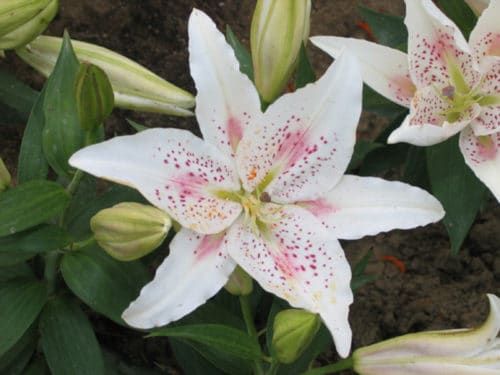

Pictured is an Eastern hybrid. When purchasing these lily bulbs, find out the varietal duration of the growing season before flowering. For the northern strip of Russia, this period should be from 90 to 100 days
Garden lilies: planting and care
Some people like lilies in flower pots, while others cannot imagine their garden without these wonderful flowers. Garden varieties are so loved by many because they feel equally good both in shaded and in areas exposed to the sun. Their only requirement is well-drained soil (Figure 6).
Note: In the summer, caring for garden lilies consists in regularly loosening the earth, weeding, combating diseases and pests, watering and feeding. Autumn is aimed at preparing flowers for winter: cutting off dried leaves, digging out, replanting and laying the bulbs for storage, organizing shelters for plants - these are the works that are carried out in the garden on the eve of winter.
Although lilies are quite loyal to shaded areas, you should still not plant them in deep shade under trees or buildings. In the fall, plant them between low bushes, which will serve as protection for flowers in the winter cold. And in the summer, it is recommended to plant ground cover plants under the lilies to protect the bulbs from overheating.
When planting garden varieties, preliminary preparation of the soil is required. Any soil is suitable, except for sandy or clayey. The first is not very fertile, and the second is prone to stagnant water. Therefore, if the soil on your site is heavy, add additional sand, as well as peat and humus to it about a month before the start of planting work. Immediately before planting, the soil is dug up with the introduction of potash, nitrogen and phosphorus fertilizers. Dug up and fertilized soil is watered and left until planting.


Figure 6. Stages of caring for garden lilies
The timing and depth of planting the bulbs are determined by the varieties and characteristics of the soil.It is important to know that garden species are planted in the fall so that the bulbs have time to take root well. The planted bed must be watered and mulched with peat or humus in order to protect the top layer of the earth from drying out. It is advisable to cover them for the winter with special devices or natural material, such as spruce paws or fallen leaves.
Caring for garden lilies consists of loosening the soil, controlling weeds, watering, feeding. Fertilization of the soil is carried out three times: during the emergence of shoots - with the help of carbamide and complex fertilizer, in the budding phase - with the introduction of potassium sulfate and superphosphate, during flowering - with a solution of liquid mullein and nitrophoska. Do not forget that watering can only be carried out by the root method so that waterlogging of the leaves does not lead to burns or lesions with gray mold. During heavy rains, it happens that the bulbs begin to protrude from the soil. In this case, the lilies must be sprinkled with fallen needles. If the purpose of growing is to obtain planting material, it is necessary to cut the buds so that the plant does not waste its energy on flowering, but directs them to the bulbs. In this case, it is necessary to leave at least a third of the stem. It is recommended to replant garden lilies every five years. So they get sick less often and bloom better.
Lilies: a little about bulbous
Lilies are perennial bulbous plants that can easily grow without transplanting for up to 5 years.


It is important to choose the right area in the garden where the flowers will feel comfortable. The best option would be a well-lit place, protected from gusts of wind.
Also make sure that there is no groundwater nearby, otherwise you will have to provide drainage, as lilies love moisture, but suffer from excess water. As for the soil, it should be loose, fertile, with neutral acidity. In dense soil, it is difficult for lilies to fully develop, therefore, in this case, the soil will have to be diluted with sand and humus. The ideal option is loam or sandy loam.
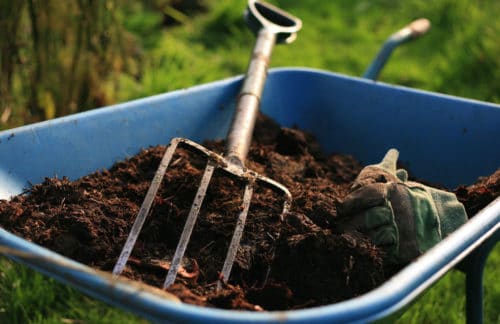

When choosing fertilizers, you should focus on phosphorus-potassium dressings and humus. Organics should be treated with caution so as not to overdo it. From an excess of nutrition, the development of lilies slows down
The best time for planting is autumn. In the post-flowering period (starting in late August and continuing until mid-October), it is recommended to plant almost all types of lilies. Spring planting is suitable for late flowering varieties. Lilies will normally tolerate temperature changes in spring, and easily overwinter, covered with foliage or spruce branches.
There is an international classification according to which lilies are divided into:
- Asian;
- Curly;
- Snow white;
- American;
- Long-flowered;
- Tubular;
- Eastern;
- Interspecific;
- Wild growing.
Each of the varieties has its own characteristics: stem length, size, shape and color of flowers, sizes, etc. This variety allows you to choose a plant for every taste.
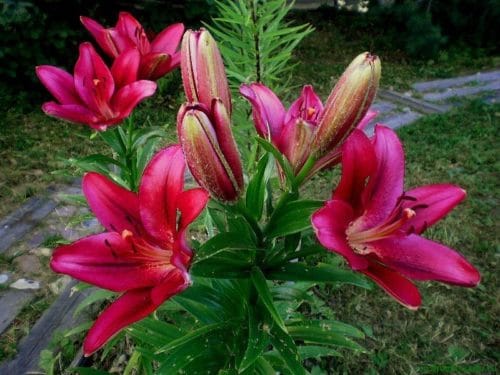

Asian hybrids are most in demand by gardeners around the world. Due to their spectacular appearance, unpretentiousness and good frost resistance, they are also popular in Russia.
Pineapple lily: planting and care
The pineapple lily, also known as eukomis, is an ornamental plant. The main advantage of this plant is that it is practically not susceptible to diseases, besides, eukomis blooms for a long time (Figure 7).
It is planted in the ground in spring in the same way as gladiolus bulbs. This should be done after warming up the soil. For the central regions of Russia, this is approximately mid-May, for the Moscow region - the end of spring. Immediately before planting, the eukomis bulbs are kept for two hours in an infusion of a root growth stimulant.


Figure 7. External features of pineapple lilies
The planting material is completely immersed in fertile soil, watered moderately.After germination, top dressing is carried out and continues to water, but more abundantly. In order to be guaranteed to get flowers after planting in spring, it is recommended to choose only large specimens that are dug up in the fall after the leaves turn completely yellow. Bulbs are overwintered in a cool room at a temperature of + 10 + 15 degrees in a box with sand after preliminary drying.
Preparation for wintering
Species and varieties of lilies with an early flowering period tolerate wintering well. Therefore, in the fall, watering is gradually reduced, then the stem is trimmed to the soil surface and a cover is made of sawdust or fallen leaves.
It is recommended to dig up the bulbs of late-flowering lilies and place them for storage in a cool room (basement or cellar) with good ventilation or on the lower shelf of the refrigerator, after packing them in a bag with peat. They won't survive the cold winter conditions outdoors.
Lily Marlene: planting and care
Lily Marlene is capable of simultaneously releasing up to hundreds of pink buds on one stem. Another interesting feature of this variety is the complete absence of the pungent smell inherent in all liliaceae (Figure 8).
Like other lilies, this species is quite unpretentious in terms of growing conditions and care. In open ground conditions, it reproduces both bulbs and bulbs. Large bulbs are best suited for home growing. Autumn and winter plantings will produce flowers in early spring, spring plantings in summer, and from bulbs planted in early autumn, you can get a beautiful flower in the middle of winter.


Figure 8. Lilies Marlene in the garden
So, for growing lilies at home, you need a flower pot, the diameter and depth of which correspond to the height of the plant. For example, with a lily height of about a meter, a container with a diameter of 35 cm and a depth of 30 cm is suitable.The bulbs are planted at intervals of 4 cm from each other, while maintaining a distance of 3 cm to the edge of the pot.If you want your indoor lily to bloom for a long time, plant 3-4 onions in one pot. Pre-planting material must be subjected to a stratification procedure, that is, a sharp change in temperature. For this purpose, the bulbs selected for planting are kept in the refrigerator at a temperature of +5 degrees for 15-20 days. Then they are soaked in a solution of potassium permanganate for 1-2 hours, then they are kept for 12 hours in a solution of a growth stimulator with the addition of a nutrient medium. Only then should the bulbs be planted in the soil.
The soil must also be prepared accordingly.:
- To do this, drainage in the form of river pebbles or expanded clay is laid on the bottom of the pot, and a layer of fertile soil 10 cm thick on top of the drainage.
- The bulbs are laid out on top of the substrate with sprouts upwards and sprinkled with a small layer of earth.
- The planted bulbs must be watered with warm water and placed back in the refrigerator (cool room) for a month so that the plant can take root.
- With the appearance of sprouts, the pot with the plant is transferred to a bright room with a temperature of + 12 + 15 degrees.
- Starting from 1 month, it is advisable to harden the plant, taking it to fresh air, gradually increasing the period of stay outside from 30 minutes to 10 hours a day.
Lilies are light-loving plants, so it is better to keep pots with them on the western or eastern windows, while avoiding direct sunlight on the leaves. In case of a lack of natural light, fluorescent lamps are used to extend daylight hours. Watering young plants is carried out with an interval of three days, as they grow and bloom, watering becomes more abundant and more frequent. In this case, it is necessary to ensure that there is no stagnation of water. On especially hot days, when the air is dry, it is recommended to spray the plants. Remember that regular watering involves loosening to ensure air flow to the roots.
Note: As for feeding, the first is carried out immediately after germination of seedlings with the help of organic fertilizers, the second - during the period of foliage growth by applying nitrogen-containing fertilizers, and the third - with the appearance of buds, when the plant needs phosphorus-potassium fertilization. If you want to increase the number of buds, treat the plant twice a week with growth stimulants.
Marlene lilies bloom 80 days after sprouting. This process can be accelerated by increasing the temperature in the room, arranging additional lighting and increasing watering, and slowing down by moving the plant to a cold place. In the third year after planting, the Marlene variety gives the most beautiful and strong inflorescences, and after 5-6 years of growth, the plant must be renewed.
As the buds bloom, they must be removed so as not to deplete the bulb. After the plant has completely bloomed, and the stems have turned yellow and dried, they begin the process of preparing for winter. To do this, watering is reduced to 1 time per week, while simultaneously making mineral dressings. Two weeks after the last leaf has dried, the bulbs are dug out, kept in a weak solution of potassium permanganate for half an hour, dried, placed in sawdust and sent to storage in a dark, cool place. It is extremely rare for the Marlene variety to have babies. In this case, it is better to plant them immediately in a separate pot.
Transplanting and dividing bulbs
In order for a lily, planting and caring for which in the open field does not require special skills, to develop well and bloom, its bulbs must be regularly transplanted to a new place. Otherwise, their stems become lethargic, and the flowers become smaller. The frequency of the necessary transplant depends on the type of lily grown:
- Curly and American lilies without transplanting are grown up to 15 years.
- Oriental and Long-flowered lilies, OT and La hybrids are transplanted every 3-5 years.
- Asiatic and Tubular lilies can be replanted every year as they grow intensively.
Transplant in the fall
The optimal time for transplanting a lily, the care of which was organized according to all the rules, is early autumn. The bulbs are dug up in August or early September, a month and a half after flowering. By this time, they have accumulated a sufficient amount of nutrients and quickly take root in a new place. With late autumn planting, there is a high probability that the bulbs will not have time to take root and will die in the frozen ground.
Children are separated from the bulbs dug out for transplantation. Often they fall off on their own, but if the daughter bulbs are tightly collected in the nest, they are cut off with a clean knife, making sure to keep a part of the bottom on each bulb. Dividing the bulbs is the easiest and most reliable way to reproduce lilies, in which all the maternal qualities of the variety are preserved.
Dry and rotting scales are removed from the bulbs, and too long roots are cut off. They are treated with antifungal drugs: 1% solution of potassium permanganate, 2% iodine, 1% ferrous sulfate, foundation. Then they are dried in a shaded, well-ventilated place.
It is advisable to plant lilies in a new place within a week after digging so that the bulbs do not dry out. Small daughter bulbs are planted separately for growing to a depth of 5-7 cm and after a year or two, they are again transplanted to a permanent place.
Spring transplant
Oriental and OT hybrids of lilies are transplanted in the spring, since they fade only by the end of August. Their bulbs are dug up in late autumn, dried and stored in a cool place. Place them in plastic bags or plastic containers with ventilation holes and sprinkle with wet sawdust or moss to keep them from drying out. The bulbs are planted in a permanent place when the threat of recurrent frosts has passed.
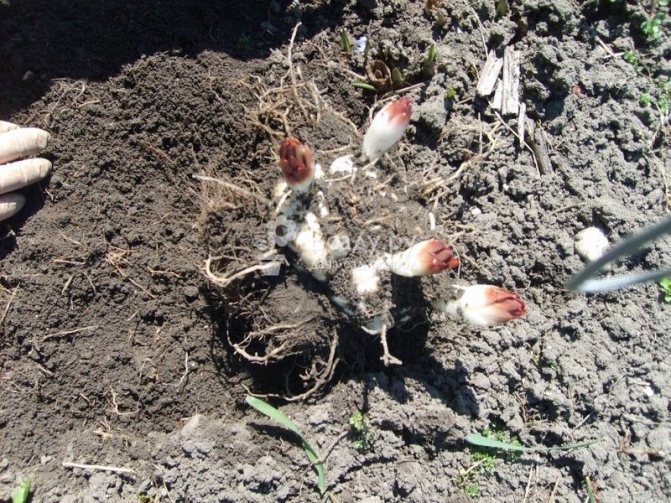

Dividing the nest of lily bulbs in spring
Spring transplanting is also permissible when growing other types of lilies, before the emergence, or at the very beginning of the development of sprouts. It is important to take into account that during spring transplantation, lilies develop rapidly and the appearance of early shoots can lead to their death due to late frosts.
Transplanting lilies in summer
Snow-white lilies need a summer transplant, the vegetation cycle of which has its own characteristics. They enter the resting phase in July-August, and by September they are already beginning to form a new rosette. When transplanting, you do not need to cut off the stem, but it is advisable to shorten the long roots to 7-10 cm. Water the lilies after the completion of the procedure should be abundant, stimulating the growth of new roots.


Lily transplant in summer
Dividing and planting lilies in July is also possible when growing Asiatic lilies. The dug nests are divided into separate stems with a bulb and immediately planted in a new place. In this case, the buds and existing flowers are cut off.
Amazon lily: home care
Among the flowering houseplants, the Amazonian lily (eucharis) is especially beautiful. Caring for a flower is not particularly difficult, because this plant can successfully grow and bloom in any room (Figure 9). The main condition for it is good lighting, so try to place the eucharis pot closer to the window. Make sure that during the summer time the leaves of the flower are not exposed to direct sunlight. The optimum temperature for growing in summer in room conditions is +18 +22 degrees, and in winter - from +15 to +17 degrees.
Note: It is also important to properly organize watering of the plant, because stagnant water can be detrimental to the Amazon lily. Therefore, it will be enough to water the eucharis when the soil under it is completely dry, and after flowering, watering stops completely, and the plant prepares for a dormant period. This stage is very important for the development of the plant, because it needs to gain strength for subsequent growth. Therefore, you need to remove the dried stalks, leaving the leaves intact.


Figure 9. Features of planting Amazonian lilies
Eucharis is dormant for approximately one month between April and October. Watering must be resumed with the appearance of new shoots. Top dressing is carried out only during the period of active growth, preferably in summer. At the same time, the fertilizer applied to the soil should not contain too much nitrogen.
An interesting feature of this plant is the fact that eucharis fully develops and blooms only in a cramped pot. Therefore, the plant can be transplanted no more often than once every three years.
Diseases to which the flower is susceptible and methods of treatment
The sooner you start treating the plant, the more chances it will be able to defeat the disease. But before providing help, you need to know exactly the cause of the disease. It may be a fungus, virus or insect pest.
Fungal diseases
The main enemy of lilies, like many other flowers, is fungal infections. Excessive humidity, care errors and lack of prevention contribute to their rapid spread.
Gray rot (botrytis)
Gray mold is the most common fungal disease of lilies. The first signs of disease can be seen at the bottom of the plant. Round or oval brown spots appear on young leaves. Gradually, they increase in size, they cover all the lower leaves, after which the infection continues to spread to the rest of the flower.


In wet or rainy weather, the affected areas are covered with a gray bloom. The reason for the appearance of Botrytis can also be improper watering, in which the water does not have time to dry before nightfall.
To prevent the mass death of lilies in the rainy season, you can build a protective canopy over the flower garden.If signs of the disease have already appeared, the affected parts of the flower should be removed and burned. And treat the surface of the diseased plant with a 1% solution of Bordeaux liquid. Spraying must be repeated every 10 days.
The causative agent of the fungus can overwinter in bulbs or plant debris. Therefore, before the spring planting of lilies begins, the bulbs must be soaked in a 0.5% solution of copper sulfate.
Basal rot (fusarium)
Fusarium infection affects the bulb, ulcers appear on it, and brown spots appear at the attachment points of the scales. Fungus infection begins from the bottom. The roots rot, the affected bulb breaks up over time. It is quite difficult to diagnose the disease, since its signs are not always there: yellowing of the leaves, starting from the bottom, and the gradual drying of the entire flower. Even a diseased plant can develop normally thanks to healthy supra-luminal roots. But during wintering, such a lily will inevitably die. The development of the disease is facilitated by waterlogging of the soil, feeding with poorly rotted organic fertilizers and high temperatures. Fungal spores can be stored in the ground for up to three years.
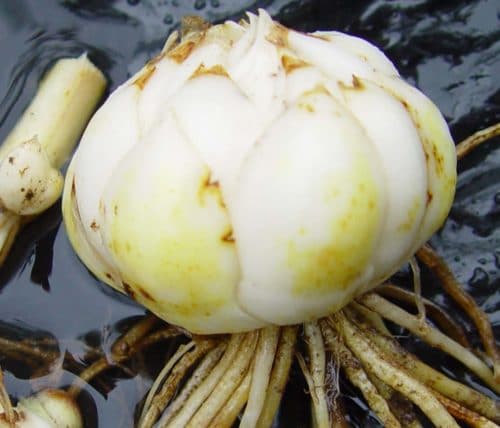

To avoid contamination of lilies with fusarium, planting should be carried out with healthy bulbs (no spots on the scales). The bulbs affected by the fungus are thrown away, and the bulbs with suspected infection are soaked in a solution of potassium permanganate
Rust
This disease affects the foliage and stems of lilies. It is transmitted through the remnants of vegetation or bulbs on which fungal spores have survived. Signs of the disease are small colorless spots, which gradually grow and acquire a reddish tint. Infected leaves and stems dry up, but spores remain on their surface, which continue to spread and infect other plants.
Rusted leaves and stems are cut and destroyed. The plant is treated with 1% Bordeaux liquid or 0.3% Cineb solution. As a preventive measure, it is recommended to feed lilies with potassium-phosphorus fertilizers.


In case of severe damage, the flowers are removed along with the bulbs and burned. Re-planting lilies in the area where diseased plants grew is allowed no earlier than three years later.
Viral diseases
Viral diseases are difficult to diagnose and treat. They are spread by insect pests (especially aphids) or through non-disinfected garden tools.
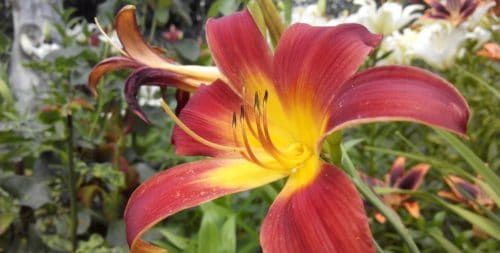

If you notice signs of a virus, the diseased plant should be destroyed as soon as possible so that the infection does not spread to neighboring flowers.
The most common viral disease of lilies is mosaic. It can be recognized by its light gray oblong spots on the leaves. At the same time, the growth of the plant stops, the stems and buds are deformed, the flowers bloom in an irregular shape and inhomogeneously colored. Sometimes a sick lily can produce healthy seeds, but it will die anyway.
Unfortunately, there are no effective treatments. It is better to prevent the emergence of the virus than to get rid of it. To do this, it is enough to regularly inspect the plants and pull out specimens with changes in the color of flowers and defects on the leaves. Also remember to disinfect the pruning shears or knife you use when cutting lilies.
Indoor lily: home care with a photo
Lovers of indoor flowers willingly grow house lilies of different varieties (Figure 10). Among them, Asian hybrids are called the most unpretentious. They grow equally well in the sun and in the shade, require moderate watering, are resistant to diseases, flowers are distinguished by many colors. The only drawback is the lack of odor.


Figure 10. Types of indoor lilies
At home, curly and snow-white hybrids are also grown. The former prefer shade and moist soil, the latter are rather capricious and demanding to care for.House lilies do not bloom for long and infrequently, but it is possible to achieve an increase in the flowering period by changing the dormant period of the plant. After flowering, it must be placed in a cool dry place or transplanted into new soil with the addition of ash. During active growth, you can feed the plant and increase watering to achieve a longer flowering.
When caring for a home lily, the following points can be highlighted:
- Regular moderate watering of the plant from the moment the shoots appear until the leaves dry.
- Spraying plants in dry air conditions.
- Loosening of the soil with the simultaneous addition of peat, wood ash, humus or leaf soil.
- Weed removal.
- Installation of supports for peduncles.
- Liquid dressing after the emergence of sprouts, at the stage of bud formation and after flowering.
- Wet cleaning of leaves.
- Store bulbs in a cool place.
It is recommended to remove the formed buds in the first year of growth so that the plant gains strength. Further, the buds are removed only from weakened plants.
Protection from pests and diseases
The most common lily disease is bacterial rot.
Cold and moist soil provokes the development of the fungus. Spots appear on the leaves, similar to yellow stains, and peduncles are gradually affected. The regulation of irrigation, the exclusion of nitrogen from fertilizing will help protect the plant from this ailment.
If bright orange spots appear on the flower, it means that another disease has appeared - rust.
Rust persists on the bulbs, so they must be carefully inspected before planting and treated with fungicides. When a disease appears on the leaves, it is treated with Bordeaux liquid.
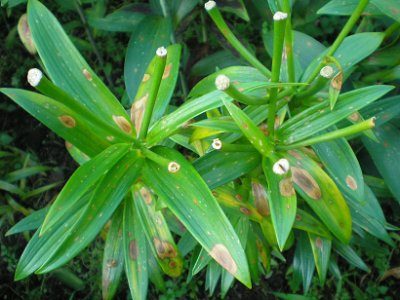

Botrytis (or gray mold) Is a real flower destroyer.
With high humidity and sudden temperature changes, it appears as dark brown spots.
Treatment with copper-containing preparations will help protect the lily.
The yellowing of the tips of the sprouts indicates decay of the root.
Such a disease requires radical measures - the plant will have to be dug out, since rot forms on the roots of the bulb, and it will not be possible to get to it without this.
The dug out onion is cleaned of lesions, treated with a fungicide. If the roots are severely affected, the bulb cannot be saved.
Diseases are not the only cause of poor lily development. This flower is also loved by numerous pests: thrips, squeak beetle, aphid, spider mite, beetle, clicker.
To cope with most of them will help insecticides, for example, "Inta-vir". The preparations "Mukhoed", "Pochin", "Medvetoks", "Grizzly" are also effective in the fight against pests.
ATTENTION: Cannot be destroyed by the poison of the squeaky beetle and the lily beetle, since the poison is not able to penetrate their protective shell. These pests must be removed manually.
Lily species
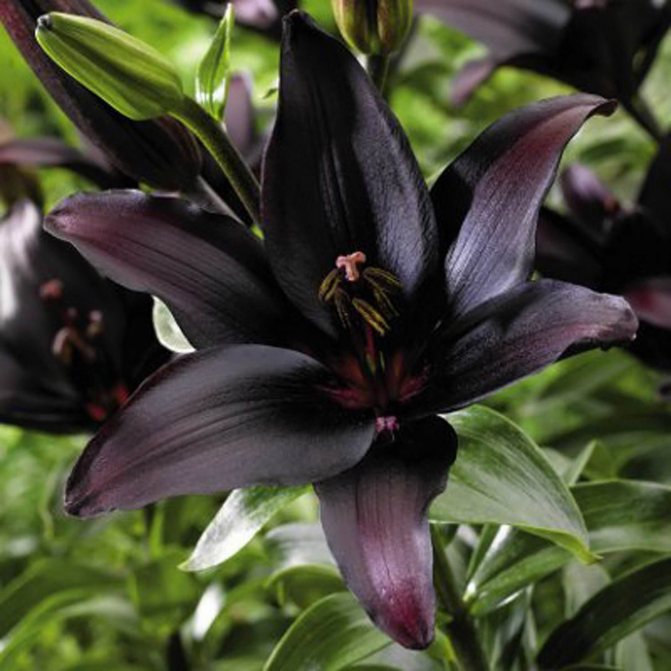

The list of the genus includes more than 110 species included in 9 groups... Thirty species and many varieties are grown in gardens and summer cottages. On the territory of Russia, there are about 16. It is worth noting the following varieties:
- Marlene. This plant belongs to the group of Asiatic lilies. Abilities such as: tolerate frost, form a large number of shoots are the advantage of the Marlene lily. Planting and leaving these representatives of the Asian group does not cause great difficulties, therefore they are often used as the main plants for breeding new varieties. The stems are light green in color and grow up to one meter in height. Flowers are quite large up to 20 cm in diameter and are odorless. Due to its unusual shapes, it is also called pyramidal.
- Regale. A representative belonging to the group of tubular lilies. The plant is very popular for its snow-white flowers, reaching up to 25 cm in diameter and with a delicate scent reminiscent of jasmine.
- Casablanca. It belongs to oriental lilies and is a rather tall plant, reaching up to 120 cm in height.On each stem, up to nine snow-white flowers with a pleasant smell can bloom.
- Tiger. It is a perennial herb that grows up to two meters in height. Due to its winter hardiness, it is popular with gardeners in Siberia and the Russian Far East. Differs in orange flowers with purple spots, the petals of which are strongly curved back.
- Soft music. A representative of oriental hybrids with delicate pink flowers with a fragrant scent. Stems with many dark green leaves can grow up to 120 cm in height. This species is very stable after cutting.
Separately, I would like to note the tree lilies. These include fairly tall species, which can well be attributed to trees. These include such varieties as Scheherazade, Anastasia, Donato, etc.
Answers to readers' questions
Plant lifespan
Lilies in one place grow on average for about 4-5 years. Then it is necessary to plant the resulting additional bulbs, maybe renew the soil and for quite some time the lilies will delight you with their flowering. It is believed that the normal lifespan of a lily is 2-3 decades.
Why doesn't the flower bloom?
There are several reasons for the absence of flowers on a plant:
- too young age and underdevelopment of the bulb;
- poor rest in winter (or complete absence of a rest period);
- too poor substrate and lack of nutrients in the soil;
- an unreasonably voluminous pot, in which the lily will grow exclusively leaf, root and bulbous mass.
Classification according to V.M.Baranova
Monstera - varieties of ampel type
According to V. Baranova's classification, eight stable features have been identified. On their basis, the genus is divided into 11 sections:
- Lilium - horizontal arrangement of flowers, their color is white;
- Eurolirium - drooping flowers, leaves are red, green or white;
- Martagon - flowers grow to the sides or up;
- Pseudomartagon - drooping flowers, leaves of various shapes and colors;
- Archeltrion - direction of flowers to the sides or up;
- Regalia - horizontal arrangement of flowers, snow-white perianth;
- Sinomartagon - drooping flowers;
- Sinolirium - upward direction of flowers;
- Pseudolirium - flowers look up, leaves are arranged in turn;
- Nepalensia - flowers directed upwards, perianth in the form of a bell.
Economic value and application
Rose Red Intuition (Red Intuition) - description of the garden variety
Lilies are used in perfumery. Their scent is believed to be able to calm the nervous system.
Important! Some varieties are poisonous. Their pollen and juice contain poison.
In Siberia and the Far East, oat and two-row lily bulbs are eaten.
Use in landscape design
With the right combination of decorative lilies with other plants, it is possible to create very beautiful flower gardens that will delight with flowers all summer. Red lilies go well with peonies and delphiniums, juniper, astilbe and alyssum. Water lilies are often used in swimming pools.
The orange lily is paired with plants that have large and spreading leaves. Barberries, magonia, euonymus will be a good background for them.
Tall varieties are planted as a background or as a hedge. Flowers look beautiful against the foreground of trees. Low grades will accentuate the tracks.
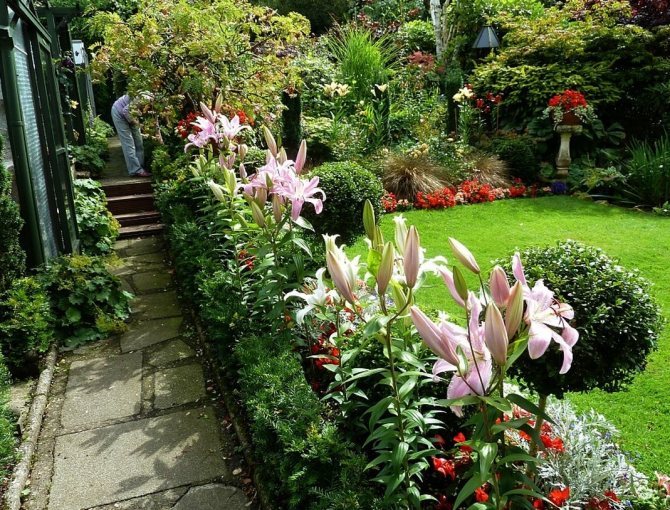

Lily combined with other plants
Myths and legends
Lily flowers are often featured in various tales, legends and stories. Even in ancient times, they were considered a symbol of good luck and prosperity. The inhabitants of Ancient Greece associated them with hope, in Russian culture, lilies symbolized purity and peace, and the French associated them with compassion, justice and mercy.
There is a belief that snow-white lilies are drops of milk of the goddess Juno herself. Allegedly, it was from them that the entire Milky Way was formed, and on Earth they acquired the appearance of picturesque plants.


The ancient Persians knew this flower even earlier than the Greeks. This can be evidenced by the name of the Persian capital - Susa, that is, "city with lilies". The inhabitants of Ancient Rome actively used lilies at the holidays in honor of the goddess of spring Flora. In Catholic states, this culture is considered a gift to the Virgin Mary. But the lily received the widest popularity in France. Historical information about this flower is associated with many monarchs. In ancient times, this country was called the lily kingdom, and its rulers were called the kings of the lilies.
One way or another, all historical references are associated with the fact that the lily symbolizes purity and spiritual purity. It was considered so not only before, but also now.
Ranunculus: growing and care at home


